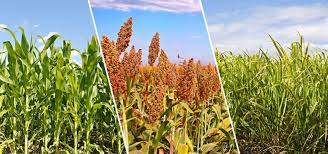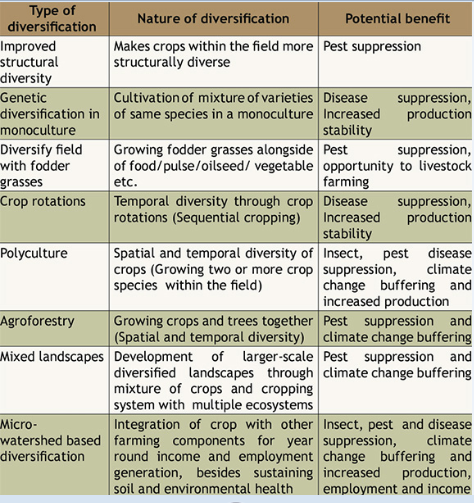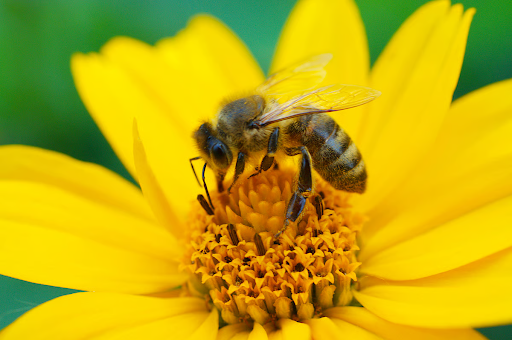Description

Disclaimer: Copyright infringement not intended.
Context
- There is an urgent need for crop: 2021-22 Annual Economic Survey.
Crop Diversification
- Crop diversification means growing more than one crop in an area.
- Diversification can be accomplished by adding a new crop species or different variety, or by changing the cropping system currently in use. It can also include an integration of crops and livestock, defined as mixed farming.
- Crop diversification is a strategy applied to grow more diverse crops from shrinking land resources with an increase in productivity in the same arable land.
Need for Crop Diversification
Water Stress
- Areas growing paddy, wheat and sugarcane are seeing baseline water stress of over 80%, with the ground water extraction rate having crossed 100% in Haryana, Punjab, Rajasthan and Delhi,
- Himachal Pradesh, Tamil Nadu and Uttar Pradesh have also seen dangerously high levels of ground water usage.
Poor oilseed production
- Failure of oilseed production to match consumption requirements, leading to a crippling import bill. It’s important to reduce dependency on imports of cooking oil.
Climatic vagaries
- A farmer confronts a series of adversities and climatic vagaries during agricultural production, such as erratic rainfall, stone hail, drought, flood, and so on.
Post harvest challenges
- Challenges like post-harvest losses, storage and unavailability of accessible proper marketing are further aggravating the problem.
Productivity proportional to input cost
- For more than five decades, Indian agriculture has been facing severe problems related to an increase in input cost to increase productivity.
- However, the productivity proportional to input maintains for a certain time before plateauing and then progressively declines in many cases.
Declining soil quality
- Farmers have been using the common government-promoted Green Revolution cropping pattern — rice-wheat-rice for a longer time to enhance productivity.
- Unilaterally, following the same cropping pattern for a longer period of time has extracted the specific nutrients from the soil, resulting in soil deficiency in those nutrients along with a declined population of micro-fauna in the soil.
- The microfaunal population is responsible for the mobilization and absorption of particular nutrients in the crop rhizosphere.
- Reduction of the micro-faunal population in the soil is a serious issue because without micro-faunal activities, the soil is lost to self-perpetuate and its ecology for crop production.
- If we continue to follow the same cropping pattern for a few more years, it will create a deficiency of soil nutrients.
Impact of Fertilizers and weedicides
- To meet the deficiency of soil nutrients, farmers apply fertilizers periodically, which further results in a change in the soil’s chemical and biological properties.
- Weed infestations are on the rise too, necessitating the application of weedicides or herbicides to eradicate them. Thus, persistent use of chemicals declines productivity, reduces resource-use efficiency and deteriorates soil health.
Pollution of soil, crop and environment
- Mono-cropping patterns have more chances to be attacked by the same types of insects and pests, which in turn are controlled by pumping the insecticides and pesticides.
- This accumulates the residue of these chemicals in soil which pollutes the soil, crop and environment.
Reduced resource use efficiency
- The mono-cropping pattern also reduces resource-use efficiency.
- Thus, breaking the mono-cropping pattern by the introduction of diverse crops and cropping patterns helps in reviving the soil health and increasing the resource-use efficiency.
Other issues
- Currently, the human-wildlife and / or human-crops conflict, forest fires, organic matter deficit soil, monoculture, plant disease and infestation, migration and the reluctance of youth towards agriculture are a new array of problems.
Benefits of crop diversification
- Increases income on small farm holdings.
- Through crop diversification, farming households can spread production and economic risk over a broader range of crops, thus reducing financial risks associated with unfavorable weather or market shocks.
- Growing diverse produce will financially expand the market potential.
- Helps withstand fluctuation in commodity prices.
- Provides resilience to highly variable weather conditions resulting from climate change.
- Increases profits by reducing the cost of production.
- Provides more varied and healthful food, both for humans and livestock.
- Decreases pest pressure, including diseases, insects and weeds.
- Enhances beneficial pollinator populations.
- Improves soil quality.
- Increases employment opportunities.
- Diverse rotations may increase crop yields and produce quality.
- Diverse cropping systems tend to decrease the probability of widespread crop failures and pest pressure, and improve soil quality and crop yields.
- Production of diverse crops on the same land can produce many agronomic benefits in pest management by breaking insect and disease cycles, reducing weeds and soil erosion, and conserving soil moisture.
- The more diverse a farming system is with plants, animals and soil-borne organisms, the more varied the population of beneficial pest-fighting microbes in the soil.

Agroforestry and Crop Diversification
About
- Agroforestry is a land-use system that includes trees, crops and / or livestock in a spatial and temporal manner, balancing both ecological and economic interactions of biotic and abiotic components.
Benefits
- It harnesses the complementarity between trees and crops for efficient utilization of available resources.
- Agroforestry can generate food, feed, fruits, fibre, fuel, fodder, fish, flavour, fragrance, floss, gum and resins as well as other non-wood products for food and nutritional security.
- It can also support livelihoods and promote productive, resilient agricultural environments in all ecologies.
- Agroforestry contributes to a multifunctional production system which enhances biodiversity due to the creation of diverse habitat for macro- and micro-organisms and maintaining landforms for future generations.
- It provides opportunities to integrate traditionally grown crops, with other commercial crops such as cereals, oilseeds, pulses, vegetables, fruits in agrihorticulture, hortisilviculture, silvolericulture, silvofloriculture, silvimedicinal, agrihortisilviculture, aquaforestry, silvipasture, hortipasture.
- Agroforestry is an important land-use system for diversification around the world in different spheres of biological, ecological, economical and sociological considerations.
Examples
- Globally, different agroforestry practices have played a key role in crop diversification. In North America, for instance, farmers preferred agroforestry over agriculture to improve their economic gain and natural resource conservation.
- In Europe, agroforestry trees are dominated by oaks, pines, junipers and firs. In Australia, Pinus radiata and Eucalyptus globulus while in the African continent, coffee, cocoa, coconut, oil palm, and rubber are common agroforestry trees on farms.
- The major agroforestry practices in India include multifunctional improved fallows, home gardens, plantation crop-based mixed-species production systems, alley cropping, woodlots, windbreaks, protein banks, shifting cultivation and Taungya in different regions.
Integrated Farming System
- The integrated farming system is an offshoot of agroforestry, advocating the diversification of the agri-production with other associated secondary and tertiary agriculture practices.
- The role of micro-organisms, nitrogen-fixing trees, leaf litter decomposition, forest hydrology and nutrient fluxes in agroforestry is well known to promote the crop diversification with various underutilized and wild crops.
Challenges
Some potential challenges to increased adoption of crop diversification on the farm are:
- Market demand may be limited by a range of factors, such as government policies, subsidies, etc.
- Lack of infrastructure for storage and transportation.
- Absence of suitable equipment.
- Price and supply of inputs.
- Lack of technical knowledge and references regarding their production practices.
- Lack of crop varieties adapted to the specific region.
- Fear of increased complexity.
- Public regulations.
Way ahead and suggestions
Intercrop, Multi-crop and Integrated Crop
- There is an urgent need to change the crops and cropping pattern by way of addition of new crop(s) as intercrop and / or predecessor or successor crops, changing numbers of the crop (multi-cropping), modified cropping system and adopting a new, integrated cropping pattern with changing agronomical practices.
|
Do you know?
Traditional pattern of agriculture in India has wider crop diversity, more stable and pro-nature. In the Garhwal Himalayan region of India, Barahnaja is a crop diversification system for cultivating 12 crops in a year. ‘Barah anaaj’ literally means ‘12 foodgrains’ and is the traditional heritage of the area.
|
Funding for agricultural research
- An increase in funding for agricultural research rather than farm subsidies.
- Every rupee spent on agricultural research and development yields better returns compared to returns on money spent on subsidies or other expenditures on inputs.
Prioritizing horticulture
- Crop diversification towards oilseeds, pulses and horticulture needs to be given priority by addressing the core issues of irrigation, investment, credit and markets in their cultivation.
Coordinated action from the State governments
- While the government has adopted the use of MSP as signal to encourage crop diversification, there is also a need for coordinated action from the State governments to facilitate the shift to high value and less water consuming crops to enable realization of the objective of doubling farmers’ income in a sustainable way.
Tree diversity
- The role of trees on a farm directly and indirectly envisages the resiliency in the cropping system, along with barriers for negative externalities.
- Thus, it can be said that the tree diversity on a farm is a prerequisite solution for the promotion of crop diversity, not only at the farm level (homesteads) but also at the agricultural landscape level in different ecologies.
Policy reviewal
- Rigorous review and adjustment of macro policies that influence the relative profitability of various sectors and, as a result, the nature and pace of diversification.
https://www.downtoearth.org.in/blog/agriculture/back-to-nature-immense-need-for-crop-diversification-and-role-of-agroforestry-81458
https://www.thehindu.com/news/national/msp-needed-for-crop-diversification-but-states-must-also-facilitate-shift-eco-survey/article38354203.ece









